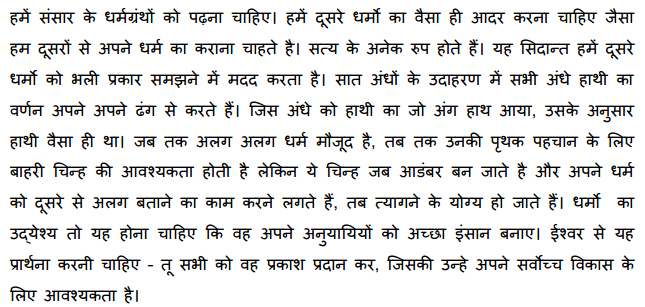
(Download) CBSE Class-12 2016-17 Sample Paper And Marking Scheme (History)
TIME: 3 HRS
MM-80
GENERAL INSTRUCTIONS
1. Answer all the questions. Some questions have choice. Marks are indicated against each question.
2. Answer to questions no. 1 to 3 carrying 2 marks should not exceed 30 words each
3. Answer to questions no. 4 to 9 carrying 4 marks should not exceed 100 words. Students should attempt only five questions in this section
4. Question 10 ( for 4 marks) is a value based question and compulsory question
5. Answer to questions 11 to 13 carrying 8 marks should not exceed 350 words.
6. Questions 14-16 are source based questions and have no internal choice
7. Question 17 is a Map question includes identification and significant test items. Attach the map with the answer sheet.
PART-A
Answer all the questions given below (2 x 3 = 6)
1. Mention any two ways of propagation of Dhamma by the Ashoka. 2
2. State any two ideas of Karl Marx on the Asiatic mode of production given in the 19th century. 2
3. Examine any two concerns of health which had given shape to Calcutta town planning during late 18th century. 2
PART-B
Section-I
Answer any five of the following questions: (4X5=20)
4. 'There are limits to what epigraphy can reveal'. Justify this statement. 4
5. Critically examine the social order of caste hierarchies laid in Dharamshastra & Dharma sutras. 4
6. Analyze the causes of the decline of Vijayanagara Empire. 4
7. How does the Ain-i-Akbari lay down the physical arrangements of the Mughal court? Explain 4
8. Examine the Fifth Report submitted to the British Parliament in 1813. 4
9. Explain the demands of the 1857 rebellions from the British govt. 4
SECTION-II
Value Based Question (Compulsory) (4x1=4)
Read the following lines and answer the question that follows:
10.Historians have discovered numerous stories how people helped each other during the partition of India during 1947, stories of caring and sharing of the opening of new opportunities and of triumph over trauma.
Highlight any four humanitarian values reflected during the above mentioned phase.
PART-C
Long Questions (8x3=24)
Answer all the questions given below:
11. 'Buddha laid stress on right conduct and values'. In the light of above message, explain his teachings on life 8
OR
In the mid First millennium BCE, the religious thinkers tried to understand the mysteries of existence and relationship between human being and the cosmic world'.
Explain
12. Explain the role of zamindars in the Mughal India during 16th
-17th century.
OR
Examine the role of Panchayats in the rural society of Mughal Empire.
13.Describe the sources from which we can reconstruct the political career of Gandhiji and the history of nationalist movement.
OR 8
How did the Salt March of 1930 mark a critical important stage in the progress of the anti-imperialist struggle in India? Explain.
PART-D
Source Based Questions (7x3=21)
14.Read the following excerpt carefully and answer the questions that follow:
. The Most Ancient System Yet Discovered
About the drains, Mackay noted: "It is certainly the most complete ancient System as yet discovered." Every house was connected to the street drains. The main channels were made of bricks set in mortar and were covered with loose bricks that could be removed for cleaning. In some cases, limestone was used for the covers. House drains first emptied into a sump or cesspit into which solid matter settled while wastewater flowed out into the street drains. Very long drainage channels were provided at intervals with sumps for Cleaning. It is a wonder of archaeology that "little heaps of material, mostly sand, have frequently been found lying alongside drainage channels, which shows… that the debris was not always carted away when the drain was cleared." From Ernest Mackay, Early Indus Civilization, 1948 drainage systems were not unique to the larger cities, but were found in smaller settlements as well. At Lothal for example, while houses were built of mud bricks, drains were made from burnt bricks.
i. Why has MacKay described this system as complete ancient drainage system? 2
ii. Was the drainage system similar in large & small settlements of Harappa? Support your answer with Facts. 3
iii. How were the drains covered? 2
15.. Read the following excerpt carefully and answer the questions that follow:
There Cannot Be Any Divided Loyality
Gobind Ballabh pant argued that in order to become loyal citizens, people had to stop focusing only on the community and the self: For the success of the democracy one must train him in the art of self- discipline. In democracies one should care less for him and more for others. There cannot be any divided loyalty. All loyalties must exclusively be centered on the state. If in a democracy, you create rival loyalties, or you create a system in which any individual or group, instead of suppressing his extravagance, cares not for larger or other interest, then democracy is doomed.
i. Why G.B. Pant wanted to see people as loyal citizens? 2
ii. What are criteria for the success of democracy? 2
iii. How does G.B. Pant define the attributes of a loyal citizen? 3




